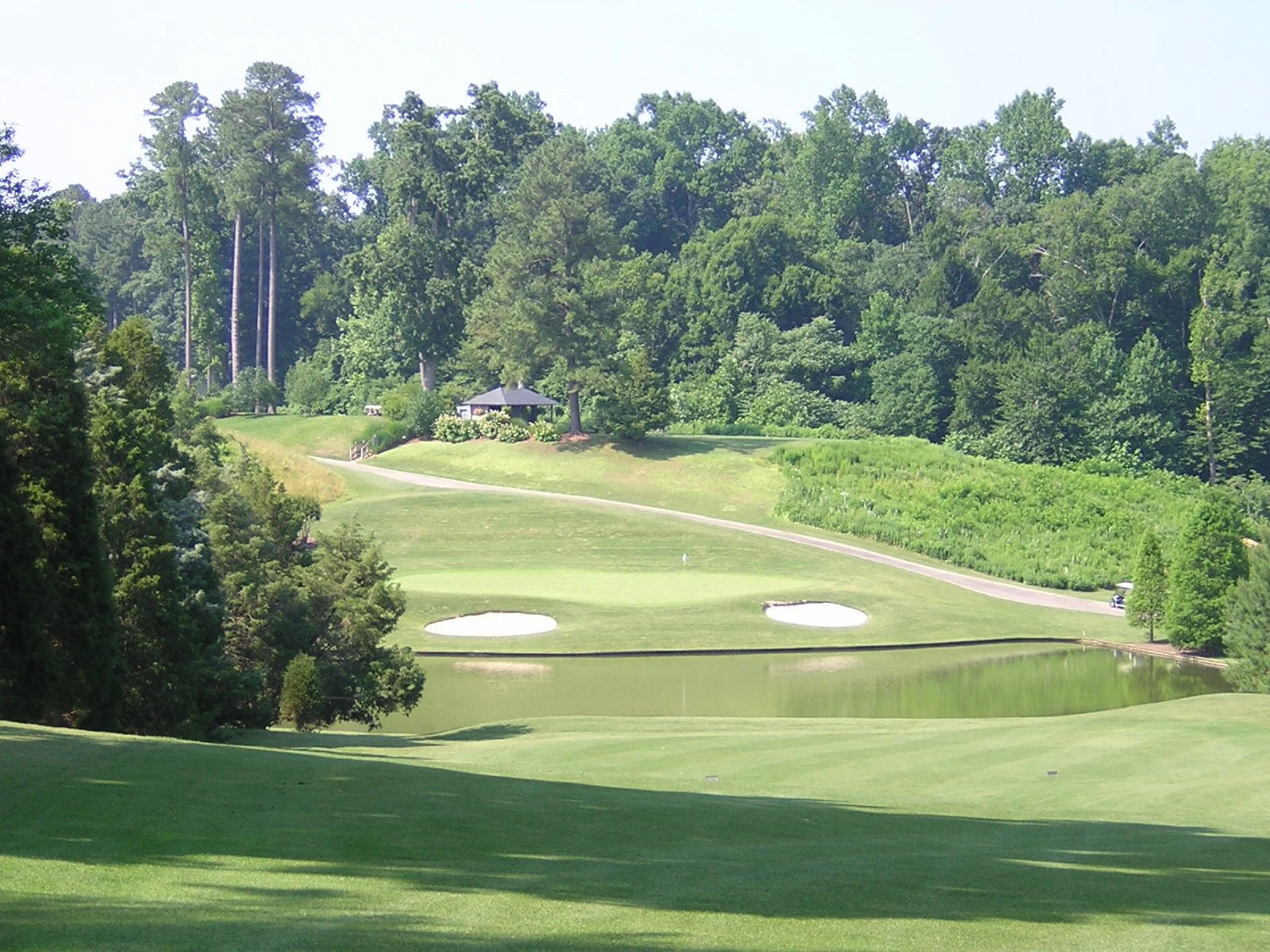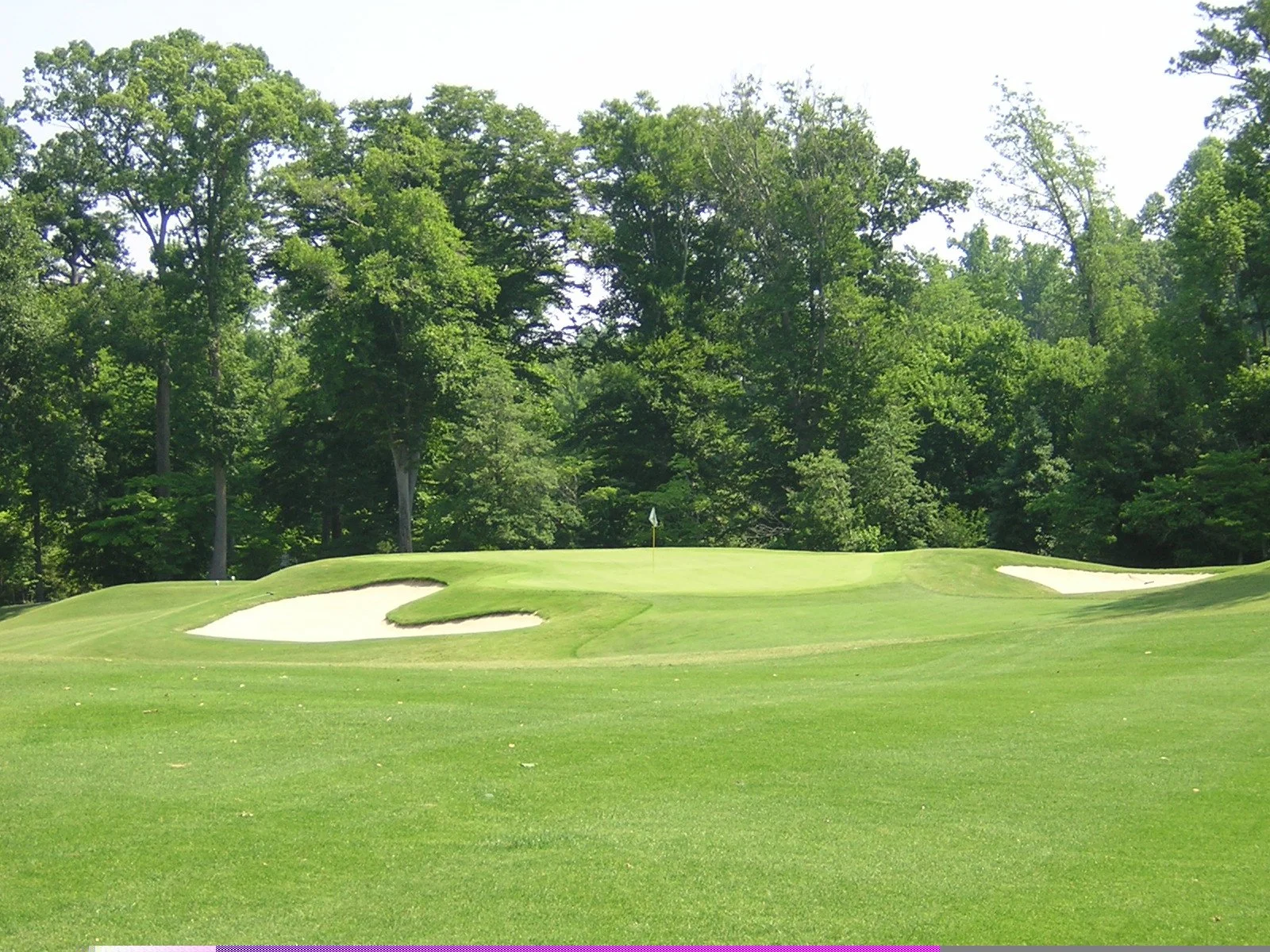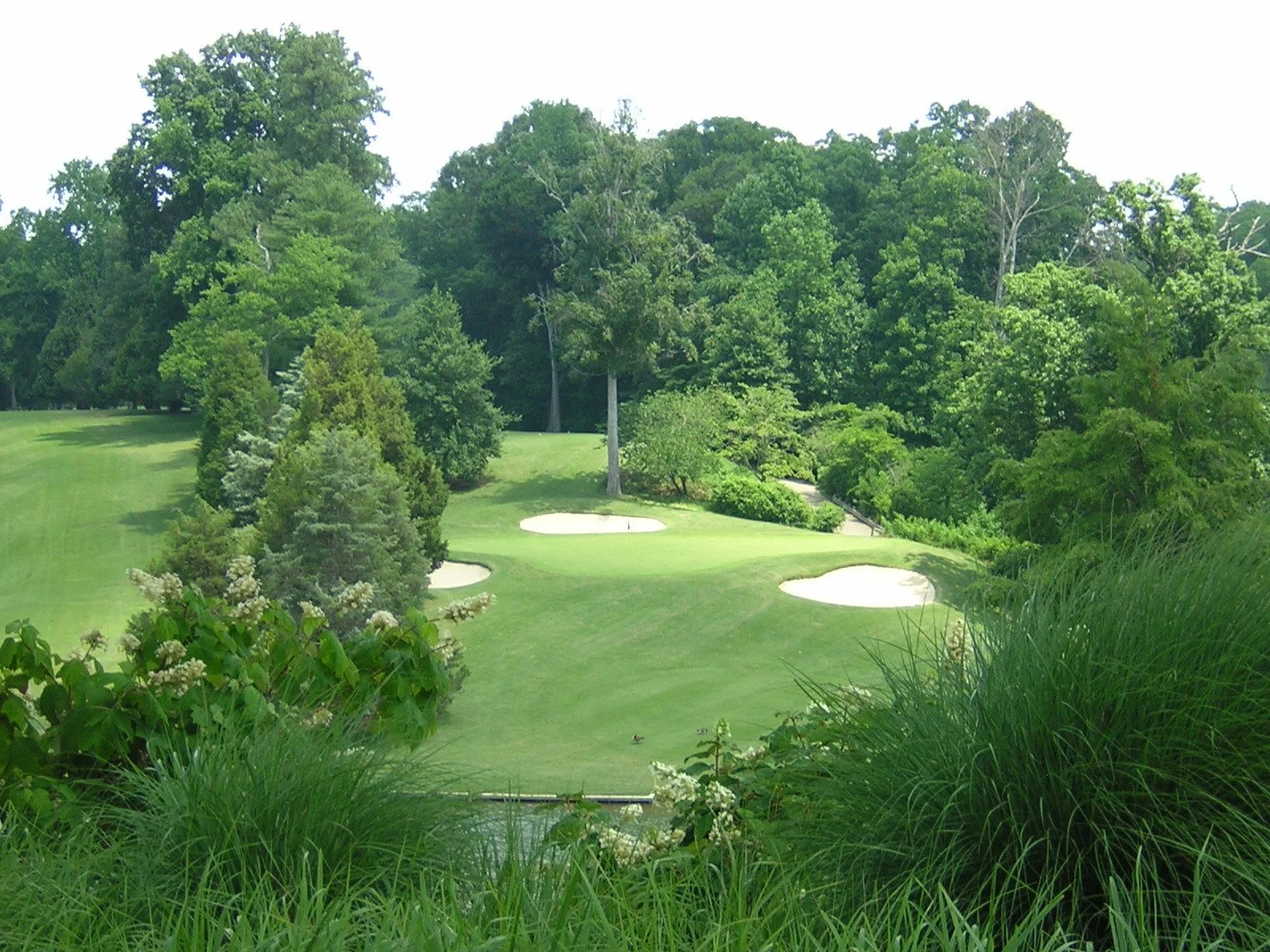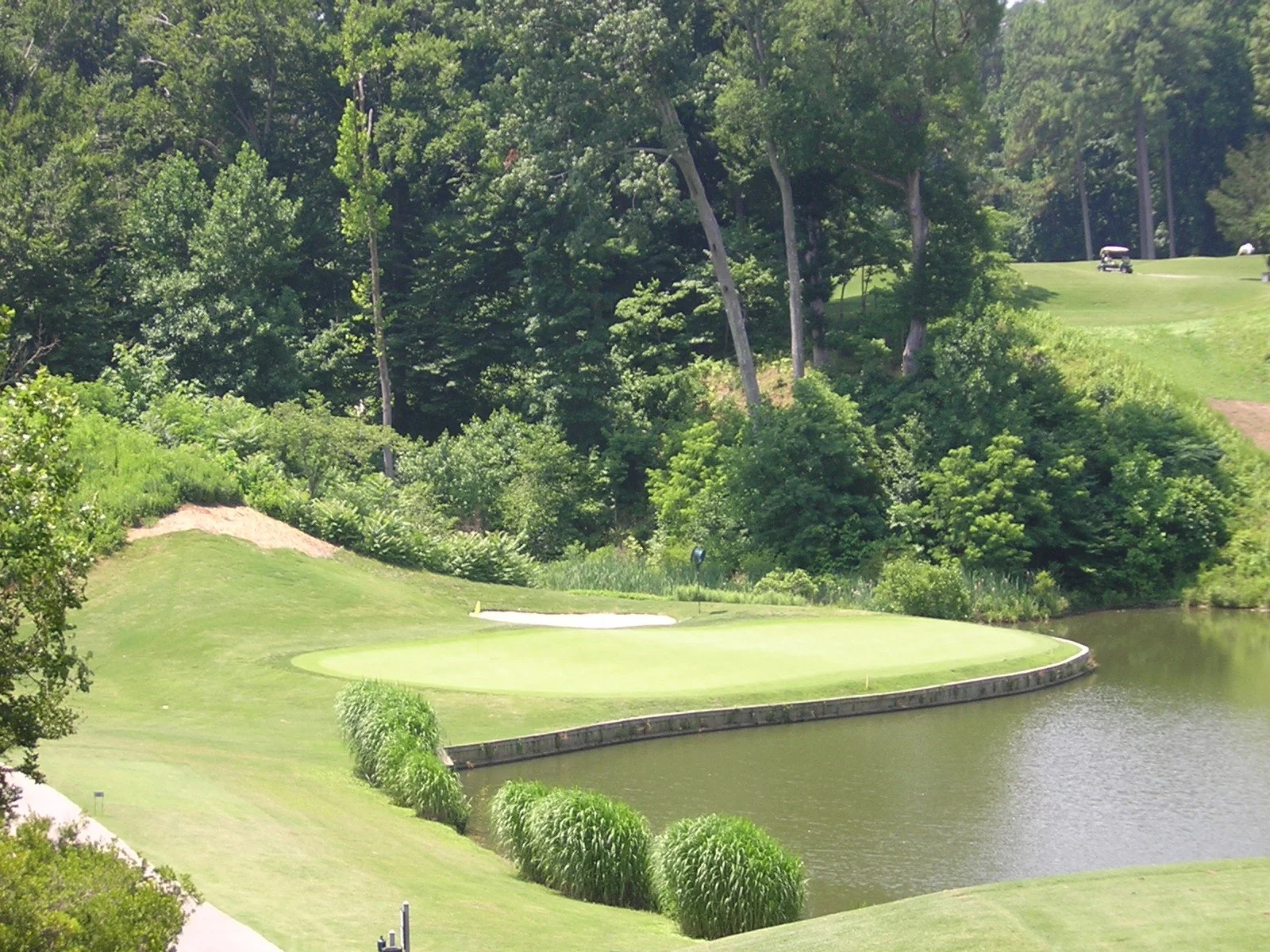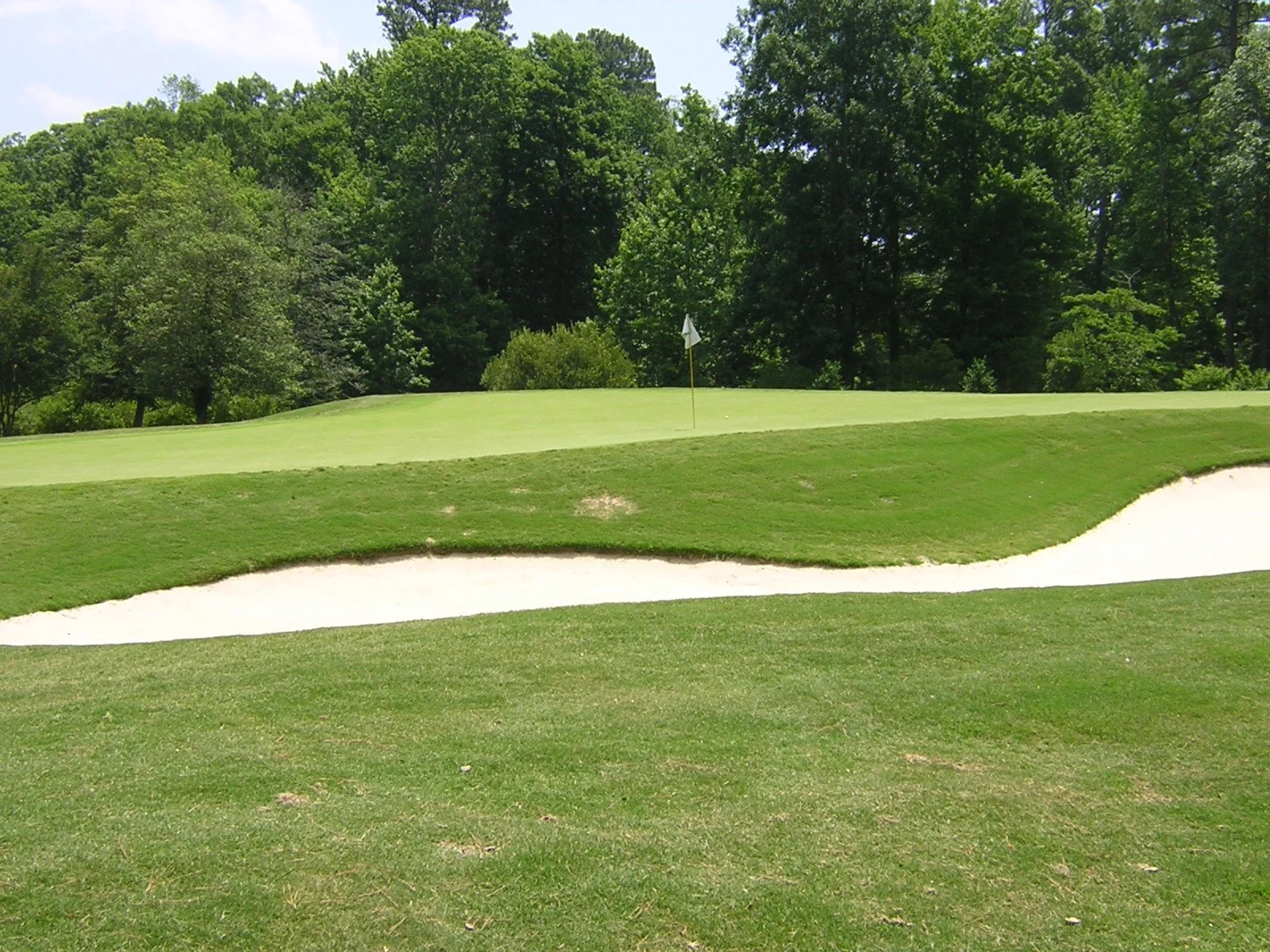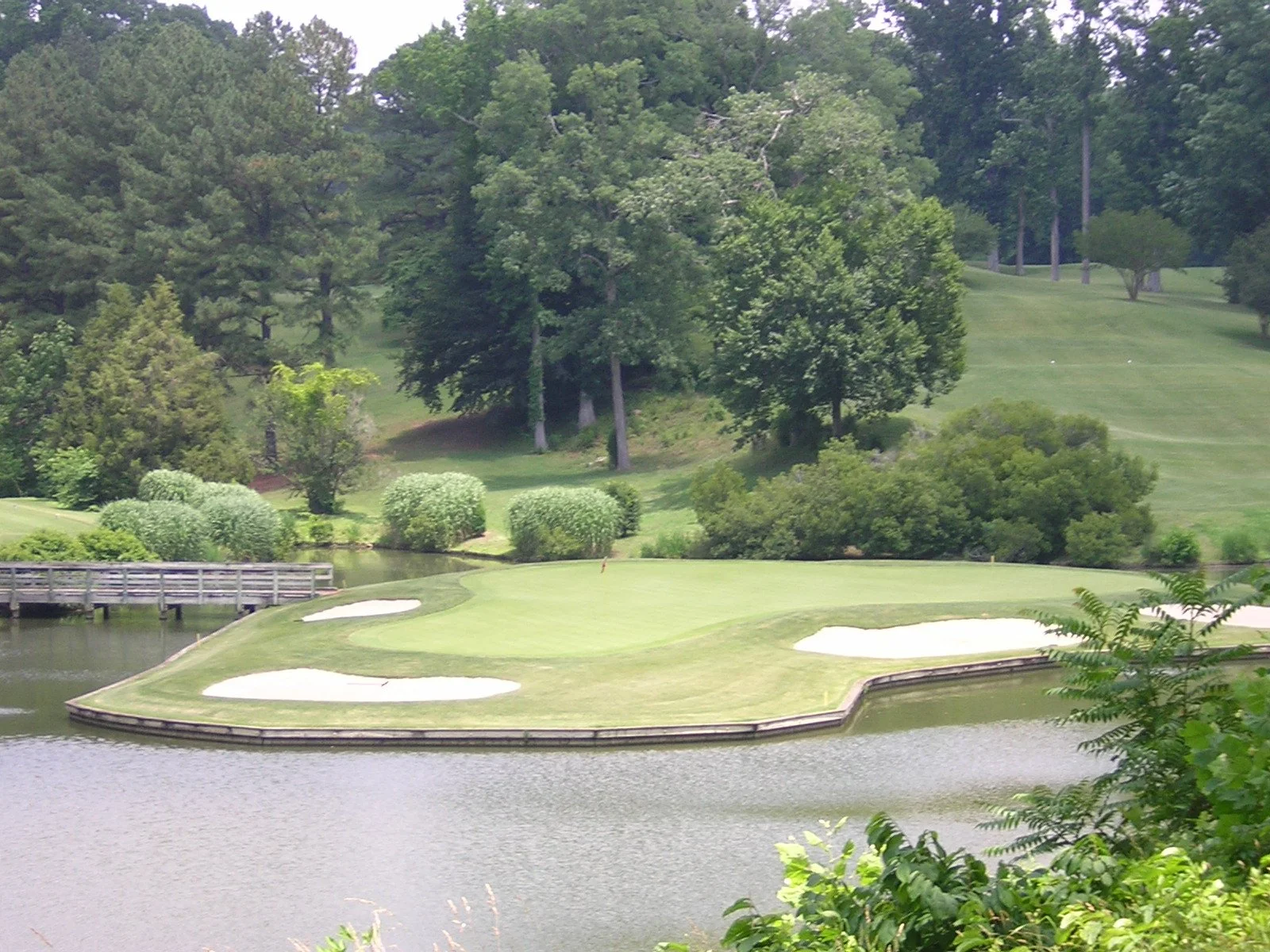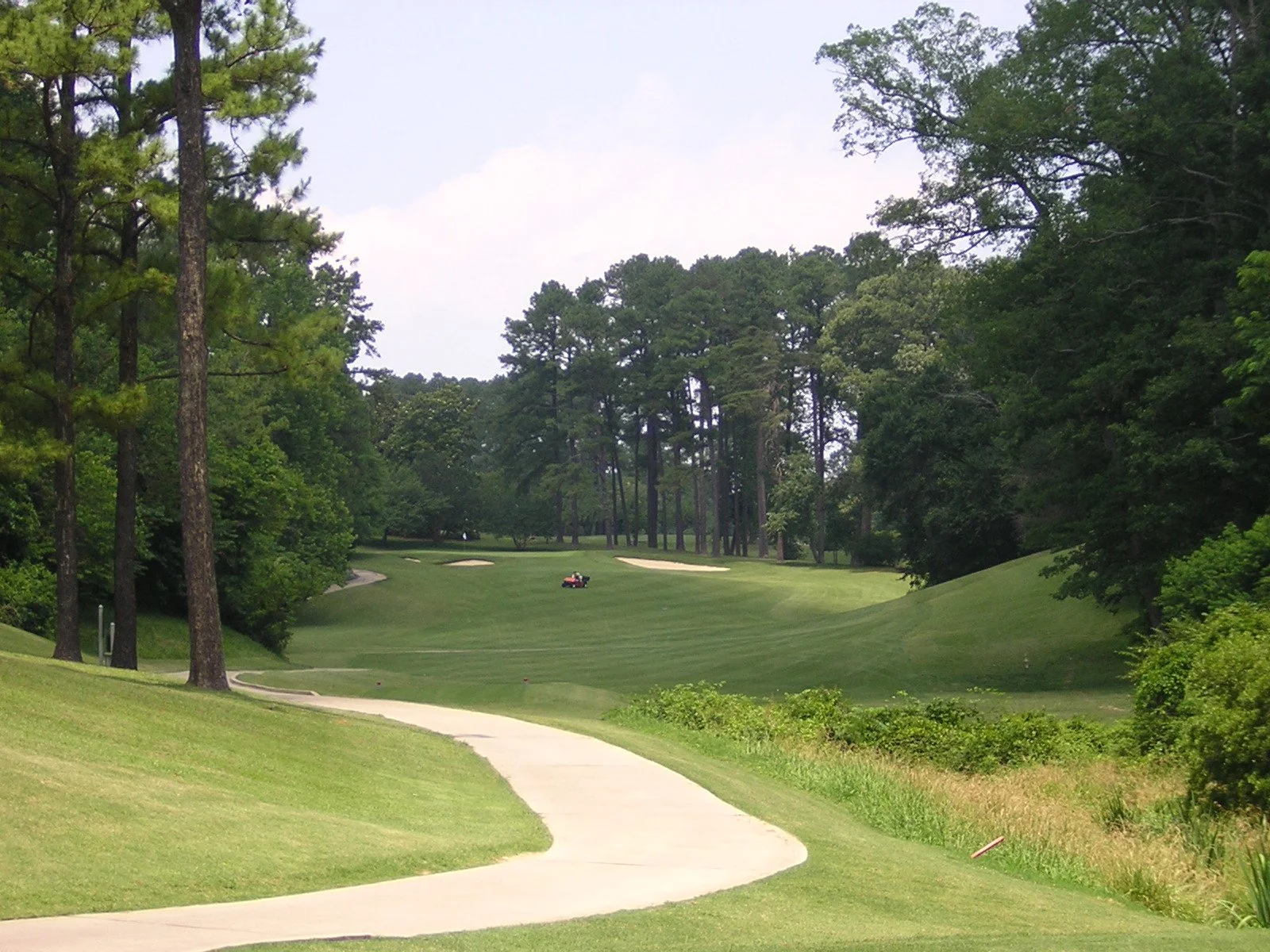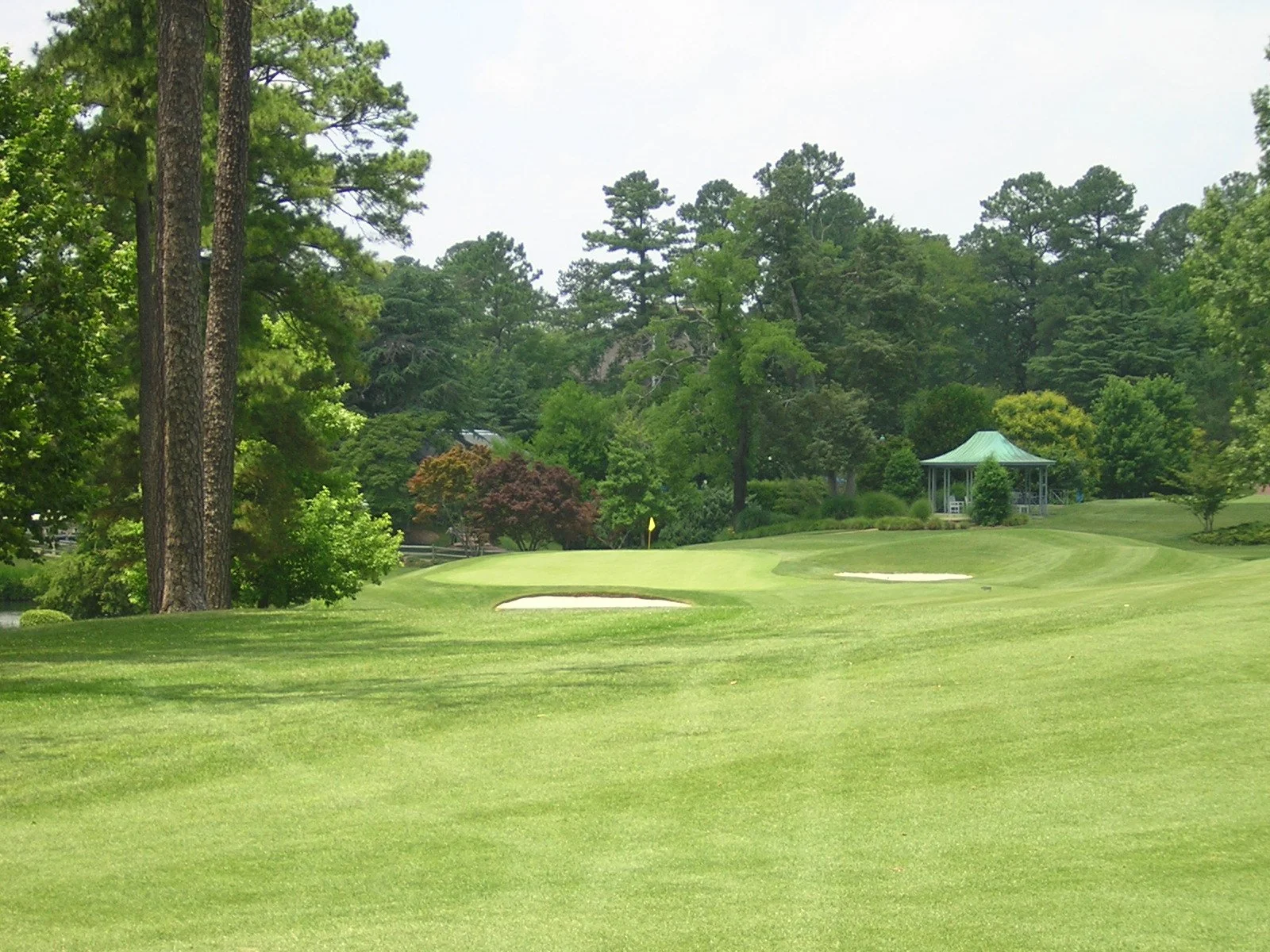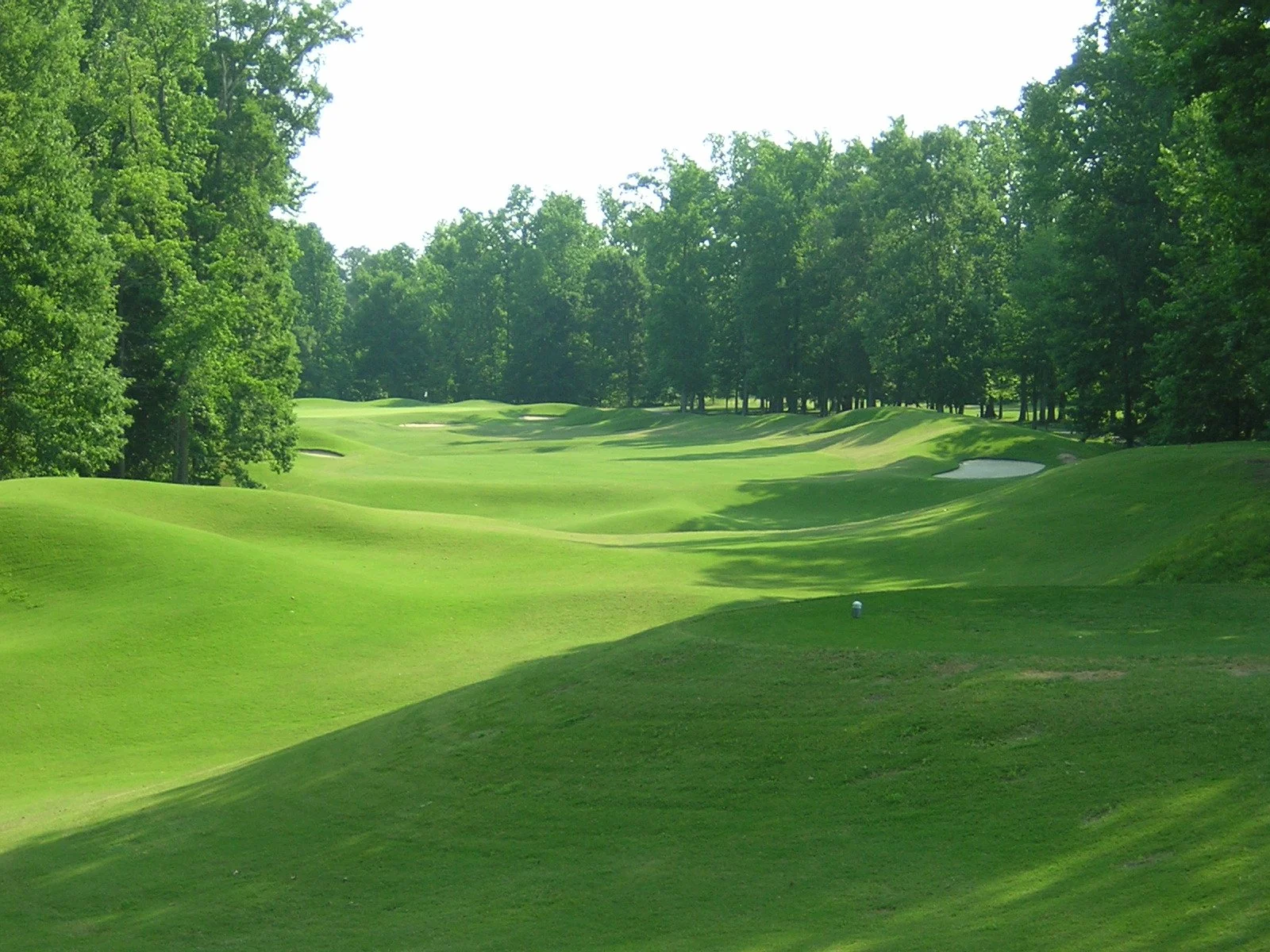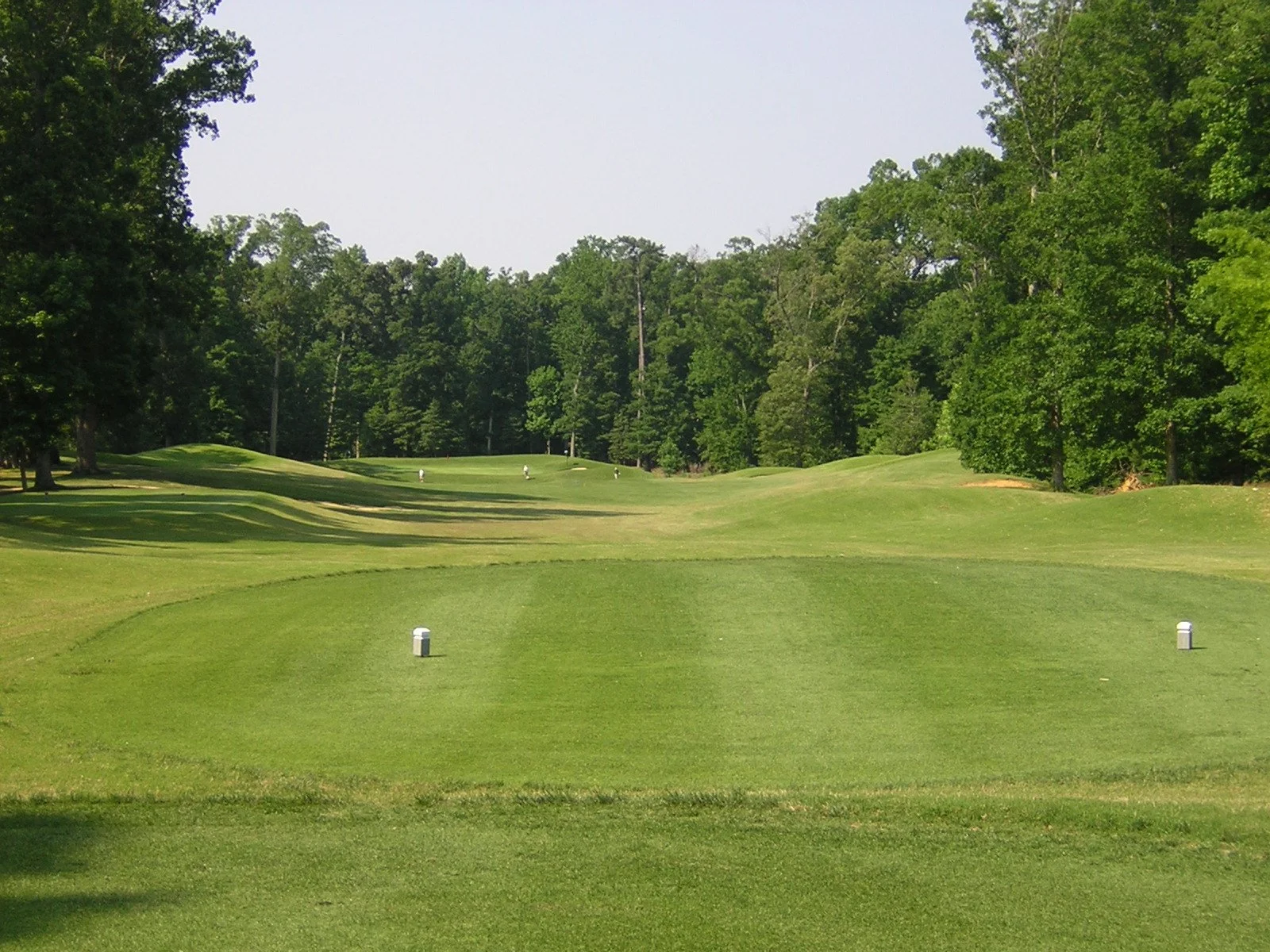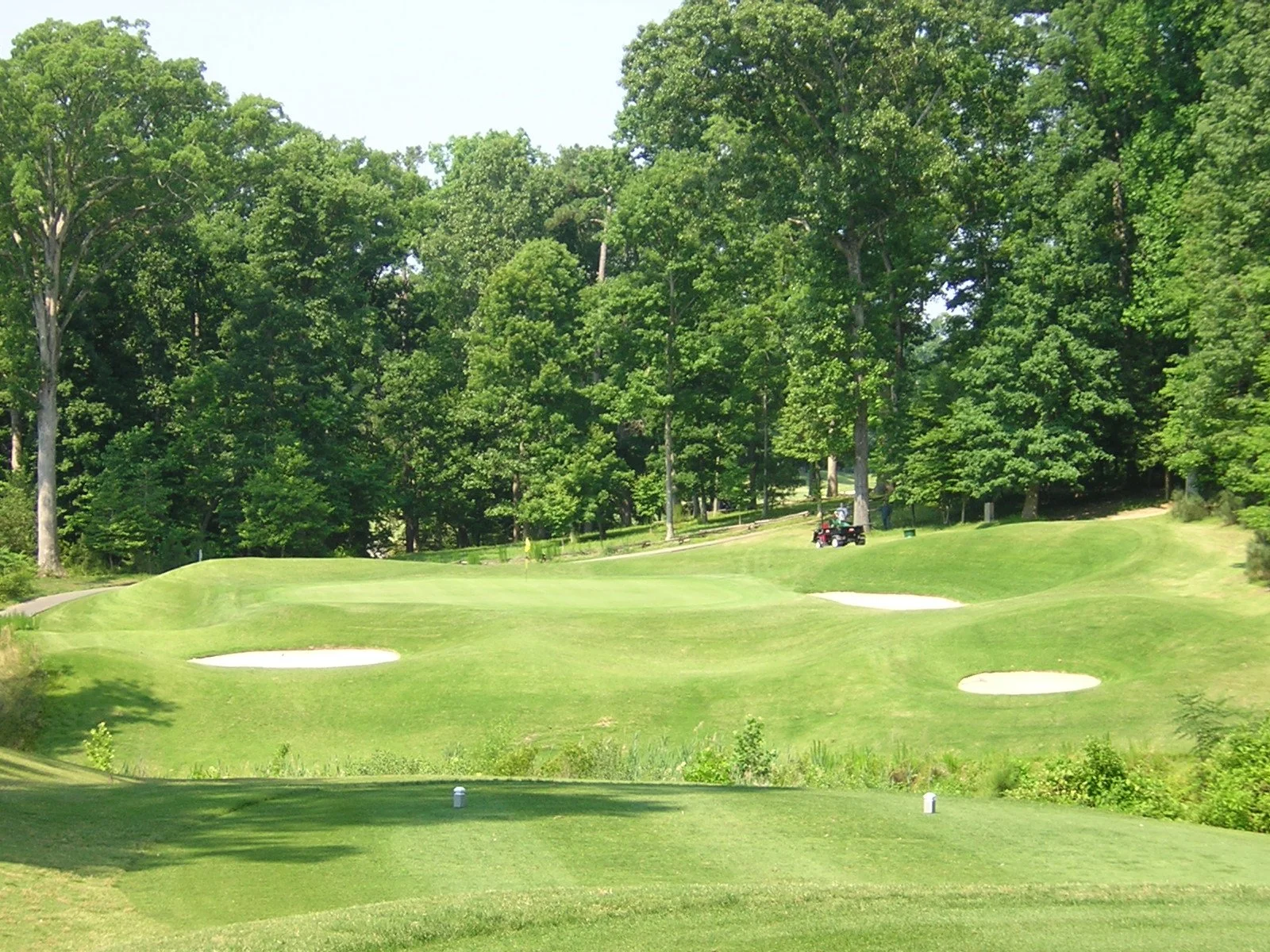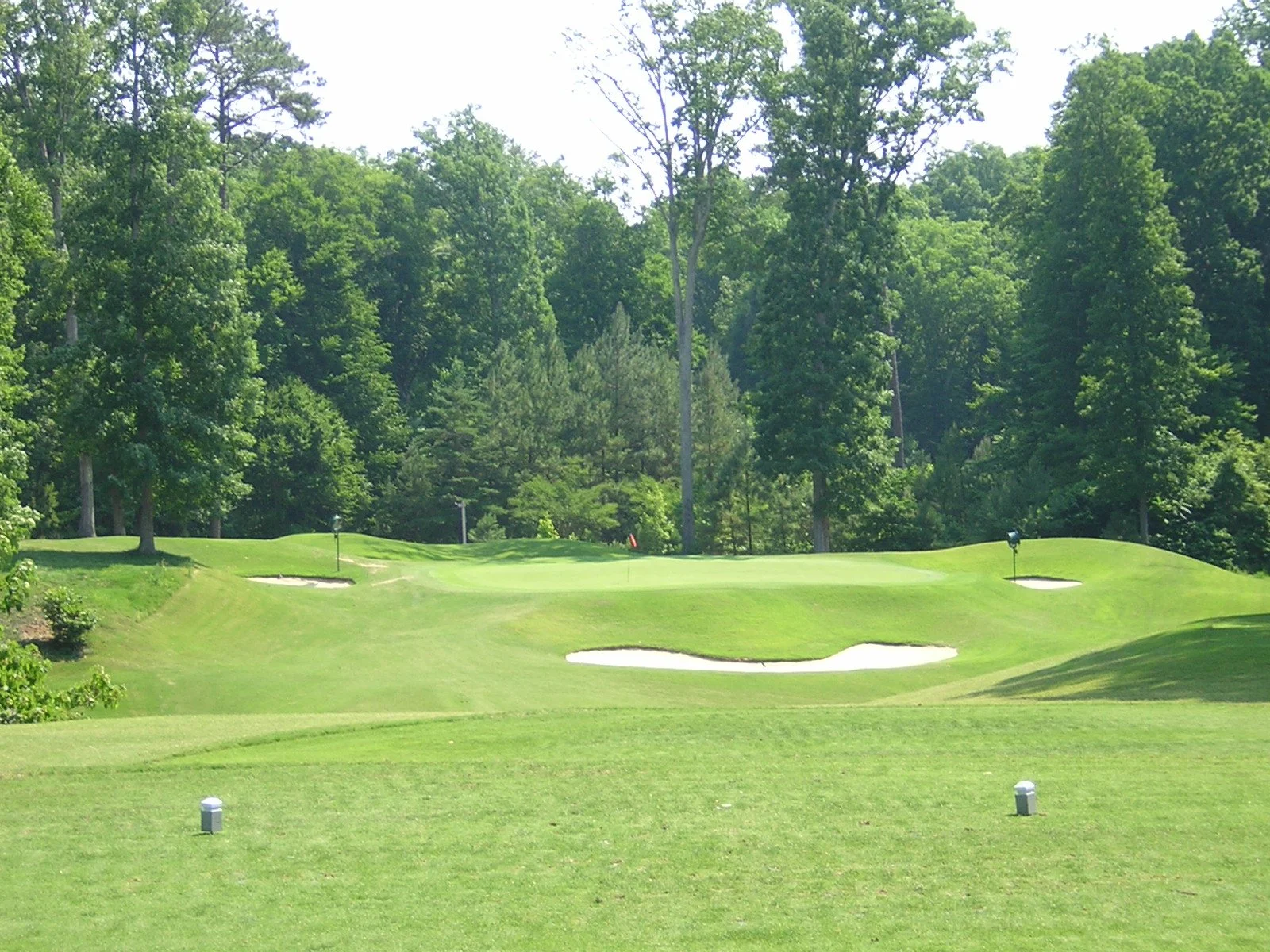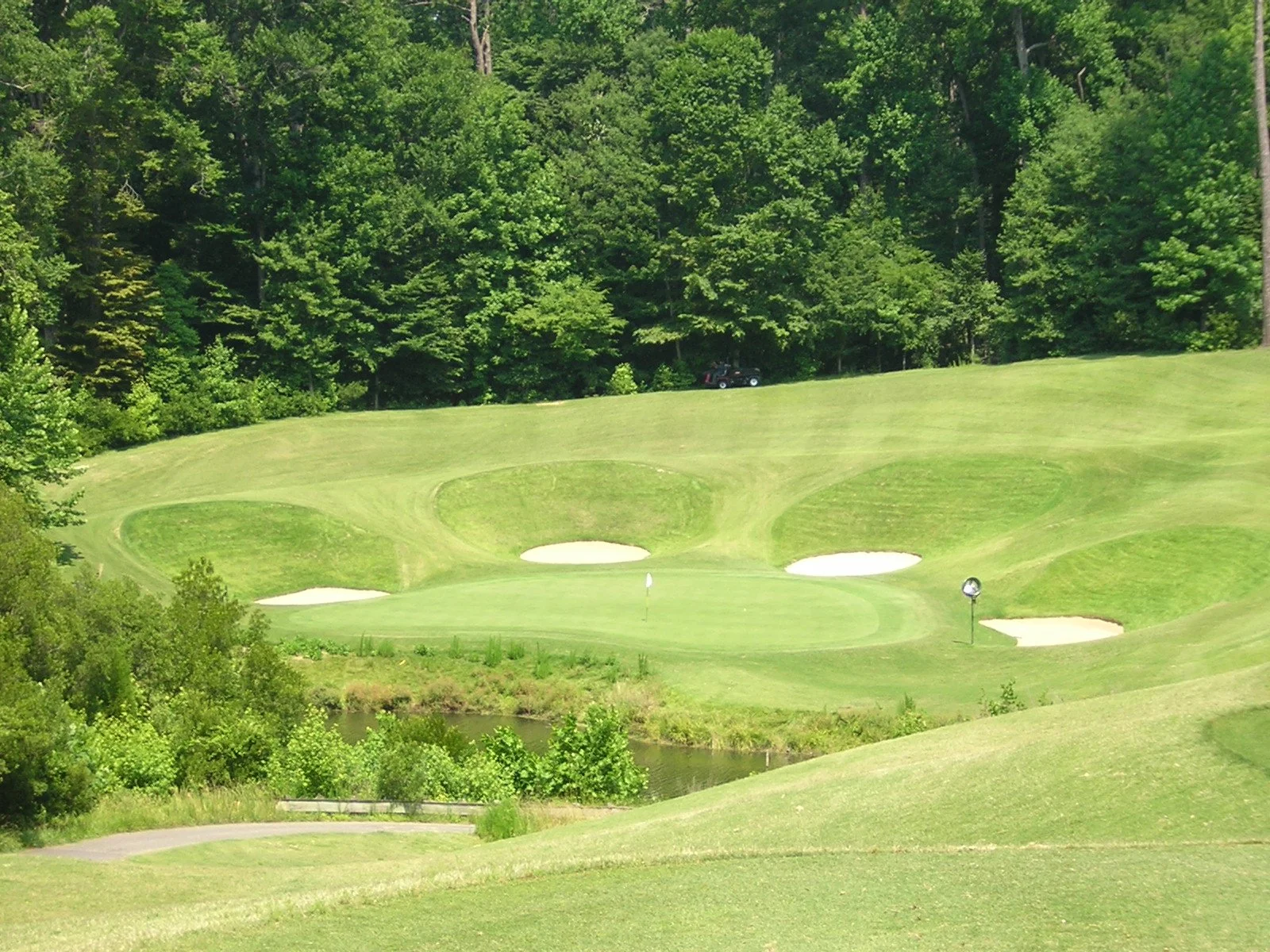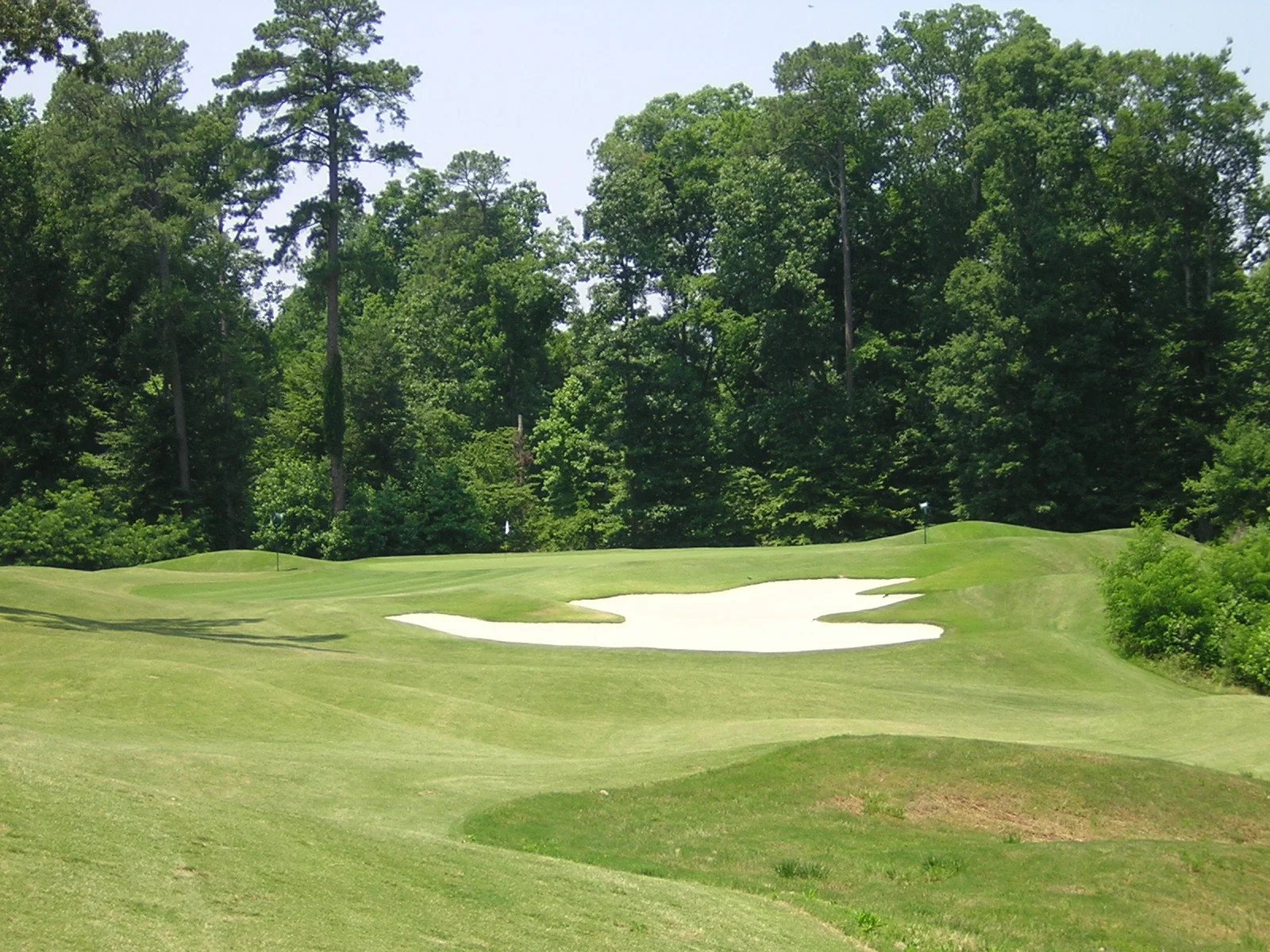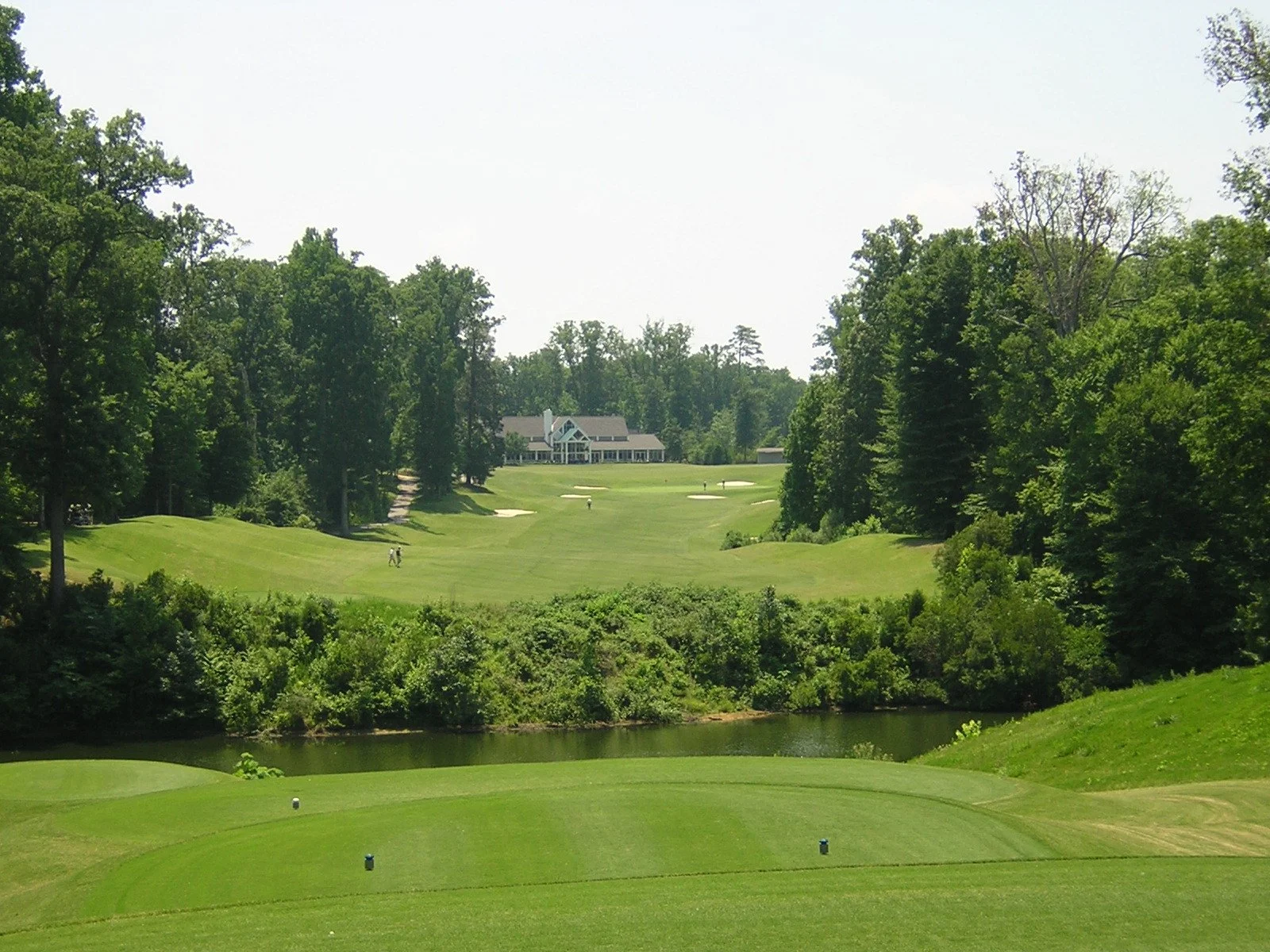GOLDEN HORSESHOE GOLF CLUB (GOLD/GREEN COURSES)
GOLD COURSE
Course Architect: Robert Trent Jones Sr, Rees Jones (renovation, 1998)
Year Opened: 1963
Location: Williamsburg, Virginia
Slope: 144 Rating: 73.8
Par: 71
Yardage: 6,817
Hole-by-Hole: 1 - Par 4 402 Yds 10 - Par 4 466 Yds
2 - Par 5 498 Yds 11 - Par 4 403 Yds
3 - Par 3 201 Yds 12 - Par 3 188 Yds
4 - Par 4 421 Yds 13 - Par 4 363 Yds
5 - Par 4 348 Yds 14 - Par 4 445 Yds
6 - Par 5 485 Yds 15 - Par 5 634 Yds
7 - Par 3 206 Yds 16 - Par 3 169 Yds
8 - Par 4 337 Yds 17 - Par 4 435 Yds
9 - Par 4 372 Yds 18 - Par 4 444 Yds
Par 36 3,270 Yds Par 35 3,547 Yds
Key Events Held: USGA Men's State Team Championship (1999),
Virginia-Carolina Team Matches (2000),
Virginia Golf Association Senior Amateur Championship (2002),
U.S. Kids Golf World Championship (2002-05),
NCAA Division I National Men's Championship (2007).
Awards Won: 5 stars in Golf Digest's - Best Places to Play (2004),
4 1/2 stars in Golf Digest's - Best Places to Play (2005-06),
Top 100 You Can Play - Golf Magazine (1996-05),
#3 America's Best State-by-State Public Courses - Golfweek (2004),
#7 Best-in-State Rankings - Golf Digest (2005),
Gold Medal Resort - Golf Magazine (2004-05),
Gold List Worlds Best 700 Places to Stay - Conde Nast (1995-2005),
America's 100 Greatest Public Courses - Golf Digest (2003),
Top 500 Golf Holes in the World (16, 17) - Golf Digest (2000),
Audubon Cooperative Sanctuary System.
Course Record: 60 (Daniel Summerhays, Michael Schachner, 2007)
Website: www.goldenhorsehoegolf.com
HISTORY: You know it's a home run when the architect calls it his "finest design." That's what you have with the Gold Course at Golden Horseshoe. Crafted by the legendary Robert Trent Jones Sr back in 1963, the Gold is as traditional a golf course as it gets.
A shot makers course with beautiful views, the Gold is not long by today's standards, just 6,817 yards in length. It features outstanding par threes, rock solid par fours, two reachable par fives and one monster three shotter. The Gold represents 125 acres, with 85 traps, six water hazards and four sets of tees, beginning from 5,168 yards.
Over the years, Trent Jones Sr has designed some masterful layouts, including Hazeltine National, Mauna Kea, Spyglass Hill and Bellerive Country Club and to consider the Gold as one of his finest designs, is quite a testament.
The Gold has hosted an impressive list of events, including a 1967 exhibition round by Jack Nicklaus. After his record-setting round of 67, Nicklaus commented, "This is a wonderful golf course...as fine a Trent Jones course as I've ever seen." Nicklaus and Mason Rudolph played against then U.S. Amateur champion Marvin "Vinny" Giles and Sam Wallace Sr, the 1967 Virginia State Amateur champion. Nicklaus needed birdies on three of the last four holes to beat Giles by one.
Including the Green and Spotswood Courses, the Gold was built on the site of the 18th-century John Saunders house and plantation, a whopping 577 acres at the time. The Saunders house foundation was excavated in 1962 and is depicted on the Frenchman's Map of 1781, one of the most historical documents used in the restoration of Williamsburg.
The Gold Course hosted the 1999 USGA Men's State Team Championship won by the state of Texas, as they defeated Virginia and Minnesota by one shot. The Texans got stellar play from Bob Kearney who shot back-to-back 68s in the weather-shortened event.
History of the club would not be complete without the Legend of the Golden Horseshoe, courtesy of Colonial Williamsburg.
The Legend of the Golden Horseshoe recalls the origins of Virginia History. In 1716, colonial governor Alexander Spotswood organized a daring expedition to explore the far reaches of the Virginia colony. Spotswood, aware of the frontier's economic potential and bent on encouraging westward settlement, led a party of 63 men on the arduous journey.
Hugh Jones offered his account in 1724 of the toll taken by the rocky soil of the Piedmont and the Blue Ridge:
"For this expedition they were obliged to provide a great Quantity of Horse-Shoes (Things seldom used in the lower Parts of the Country, where there are few Stones). The Governor, upon their Return, presented each of his Companions with a Golden Horse-Shoe, some of which I have seen studded with valuable Stones resembling the Heads of Nails."
Although several persons in the nineteenth century claimed to have seen them, none of the small, golden horse-shoes described by Jones have been found.
The Golden Horseshoe Golf Courses epitomize the tradition and mystique of Spotswood's expedition: the challenge of daring adventure, the enjoyment of a peaceful and spectacular environment, and the reward of completing an arduous test.
REVIEW: The opening hole on the Gold Course is a simple, dogleg-right par four, devoid of fairway bunkers. The landing area is quite wide, so take out the big stick off the slightly elevated tee box, thus leaving a short-iron or wedge to a very receptive green. The putting surface features a bunker on the right side and slopes from back to front. Tree lined from the middle of the fairway on in, can present problems, especially if you're long and left.
Your first look at what makes this course so special comes at the second hole and more specifically, your second shot. Another dogleg to the right, the par-five second is quite a risk-reward hole, as it only stretches 498 yards from the tips. Once again, trees line both sides of the fairway, making for a difficult tee shot. Favor the left side, as a 25-yard long trap guards sits watch on the right. The next play will be downhill towards the green or landing area. The key here is to avoid the pond fronting the putting surface. Option one. Layup with a short-iron to the bottom of the hill, leaving just a pitch over the water. Option two. Go for the green in two with a fairway metal. The putting surface is very wide and has plenty of room to err, so give it a go. Worse-case scenario, you make bogey, but what a view!
The first of four of the finest collection of par three's on any course in the land, the third is a downhill gem. This 201 yarder could be the hardest of the quartet, as it features the tightest of targets with tall trees down both sides. The putting surface is only 17 paces deep, but quite wide (36 yards). Water and sand short and one trap deep make this a bear of a par three. Missing long and right is safe, but will present a difficult up and down.
What makes the fourth so difficult (it's the number one handicap hole) is not the length, but the premium of accuracy that's placed on the player. From the gold tees it's only 421 yards long, but it bends to the right and the fairway is quite narrow, not to mention a 30-yard bunker guarding the corner of the landing zone. The green is guarded by two deep bunkers on either side and is very undulating. Let's not forget, the hole is tree-lined from tee to green.
One of the shortest par fours on the course, the fifth is relatively easy, except for the fact that it's straightaway, tight and tree-lined. A fairway metal or long iron off the tee will set up a wedge to a long, narrow green. The landing area becomes extremely slim from 100 yards in, as another long
bunker down the right looms large. The putting surface is raised with traps right and left. A back-left flag will present a very small target, making club selection key. A possible birdie chance, but beware of a double-bogey.
A perfect example of why a par five does not need to be 600 yards long. The sixth is just 485 yards in length from the back buttons. It represents quite a challenge as it bends to the right, plays downhill from the tee, uphill towards the green and is tree-lined throughout. A big drive down the left side should set up the best angle towards pay dirt. Any tee shot off line will result in trouble with a capital "T", especially if missed right as the trees are deep and dense. Laying up short of the green will result in an uphill pitch to a small, undulating green. Two bunkers short and one deep will catch any misplayed shot. Birdies and possibly eagles, but bogeys and worse can come into play.
The longest of the par three's, the seventh is another beauty. A modest 206 yards and playing downhill, this one-shotter is all about club selection. Perched in the hillside, the green is as wide as it's deep and features two tiers. Three bunkers surround the surface, while water sits well below the green. It comes as no surprise that this hole is the seventh most difficult on the course.
Another chance to get one back, the par-four eighth is short, but flanked by trees. Just a long iron or fairway metal off the tee will set up a wedge to this dogleg-left hole. The putting surface is slightly uphill with two deep bunkers, front right and left. The green slopes from back to front and is lower-case r-shaped. The object on eight is to avoid the trio of traps down the right off the tee and take dead aim at the flag for birdie.
A dogleg to the left, the ninth presents quite a challenge off the tee, as the fairway slopes towards the right, where bunkers and trees lay. Your second shot will be with a short iron to a fairly receptive green, that slopes from back to front. The object here, stay below the hole, give yourself a shot at birdie and don't be disappointed with par. It's a good score.
Not only is the back nine 277 yards longer, but it's only a par of 35 featuring five of six par fours over 400 yards in length. The first in that category is the 466-yard, dogleg-right 10th. A difficult driving hole, as trees begin where the fairway starts on both sides and any shot missing right will most likely result in a lost ball. The entire right side is dangerous and must be avoided, not to mention the deep traps left and right. The putting surface slopes from back to front and is very slick. A par here will be a great score.
Through a shoot of trees, the 11th is a straightaway par four with tall trees flanking both sides of the hole, making for a tight tee ball. The fairway slopes from left to right, and is devoid of sand. The green features only one trap (right side), but is angled to the right. As is the case on most holes,
stay below the hole for your best shot at birdie.
Quite an eery feeling, as you reach the par-three 12th. The tee box stands 40 feet above the green, which is virtually surrounded by water, sans the left. Only 19 paces deep and 39 yards wide, the putting surface is broken in two sections by a ridge in the center. A back-right pin with the wind in your face makes this one of the most demanding holes on the course.
A breather of sorts, the 13th is the shortest par four on the back nine. Playing uphill off the tee, just a fairway metal or a long iron will suffice, leaving a short wedge to the green. From the crown of the hill, the hole plays downhill to a raised green with a quartet of traps surrounding the green. The
putting surface is a whopping 36 yards wide, but just 20 deep. Depending upon the pin placement, this could be a birdie hole.
The final five holes on the Gold Course make for an amazing finish. First is the dogleg-right 14th, 445 yards in length and the second handicap hole on the course. The key to this gem, as with most holes here is the tee shot, which must thread the tree-lined fairway and avoid the trap down the right. Even with a big tee ball, a medium iron will remain to a T-shaped green with bunkers under the arms. The surface is very quick from back to front making any deep shot difficult to two-putt.
The longest hole on the course, the 15th is a monster of a par-five, 634 yards from the back tees. In fact, even from the white markers, its 600 yards. A 200-yard carry is needed just to reach the fairway on this fairly straight three-shot hole. Bunkers on either side of the tree-lined hole come into play off the tee. The landing area is free of sand, but is very narrow around the 100-yard mark. The green is the largest on the course with three distinct traps guarding the pin. A back-left pin can make this hole next to impossible. Take your par and move on.
One final beautiful par three, the 16th is another signature hole at Golden Horseshoe. The shortest of the group, this hole features one of the first island greens in golf. Depending upon the tee box, it can play from 97 to 169 yards in length. The putting surface is wide and narrow from the tips with five bunkers surrounding the green, while the left box is a bigger target, but not any easier. With such a large green, this hole can play different every day of the week.
At first blush, the 17th seems quite benign. Au contraire. Straightaway and uphill from tee to green, this par four is again tree lined with a fairway that slopes from right to left. Even with a big tee shot, a medium to long iron awaits to a putting surface that slopes from back to front with two deep bunkers fronting. The tall trees behind the hole frame the 17th beautifully.
The final hole typifies the Gold Course at Golden Horseshoe. A long, dogleg-left, tree-lined par four. The fairway is long and narrow and requires a deep blast down the right side, as any shot left will be partially blocked by the tall trees. A medium to long iron will remain to a slightly downhill placed green that slopes from back to front. The putting surface is guarded in front by a pair of traps, while left of the target will end up wet. A very demanding finishing hole, especially with the match on the line.
FINAL WORD: The Gold Course at Golden Horseshoe is a marvelous venue, complete with all the necessities of a top-100 layout.
Let's start with the course itself. Challenging and demanding even though it's less than 7,000 yards long. That's evident by the course record of just four-under par dating back to 1967. Four of the most beautiful and difficult par threes that you'll ever find. Tree-lined fairways that are so mature, you'll need tunnel vision just to dissect them. The conditioning of the course is immaculate and the greens are as smooth as glass.
The practice facility is not the largest, but it's adequate, although range balls can be found at times on the first fairway. It's hard to top Colonial Williamsburg's Ambassador of Golf, Del Snyder. A protege of the great Sam Snead, Snyder has lost count of the guests and VIPs he has helped over the years at Golden Horseshoe.
The clubhouse, overlooking the 18th green is a magnificent building which seems to have been around since the 1700s. Another remarkable aspect of Golden Horseshoe Golf Club is that all income from the club is used for the purposes of The Colonial Williamsburg Foundation, a non-profit organization, which operates the Historic Area.
The golf course is walking distance from the center of Colonial Williamsburg and is just a wedge away from Williamsburg Inn and Williamsburg Lodge, two fantastic places to stay when visiting the area.
Another attractive quality is the fact that Golden Horseshoe is conveniently located from Richmond (45 minutes), Washington D.C. (2 hours) and Philadelphia (4 1/2 hours).
Let's face it, the Gold Course at Golden Horseshoe is a must play for the avid golfer who wants to be challenged and for the family man who wants to squeeze a round in before touring the historic sites. Forget those massive 7,200-yard layouts with forced carries and enormous greens, I'll take the Gold anytime.
GREEN COURSE
Course Architects: Rees Jones, Greg Muirhead
Year Opened: 1991
Location: Williamsburg, Virginia
Slope: 138. Rating: 75.1
Par: 72
Yardage: 7,120
Hole-by-Hole: 1 - Par 4 429 Yds 10 - Par 4 352 Yds
2 - Par 4 404 Yds 11 - Par 3 195 Yds
3 - Par 4 360 Yds 12 - Par 4 444 Yds
4 - Par 4 380 Yds 13 - Par 4 396 Yds
5 - Par 5 558 Yds 14 - Par 4 466 Yds
6 - Par 4 450 Yds 15 - Par 5 616 Yds
7 - Par 3 188 Yds 16 - Par 4 397 Yds
8 - Par 5 538 Yds 17 - Par 3 220 Yds
9 - Par 3 196 Yds 18 - Par 5 531 Yds
Par 36 3,503 Yds Par 36 3,617 Yds
Key Events Held: NCAA Division I Championship (2007),
U.S. Women's Amateur Public Links Championship (2004),
Virginia State Golf Association Senior Amateur (2002),
U.S. Kids Golf World Championship (2002-03),
NCAA Division I Eastern Men's Regional Semifinals (2001),
USGA Women's State Team Championship (1999),
USGA Senior Women's Amateur (1998).
Awards Won: 4 1/2 stars by Golf Digest - Best Places to Play (2002-06),
Top 100 You Can Play by Golf Magazine (1996-2006),
America's Top Golf Courses by Zagat Survey (2006-07),
Ranked #4 best new resort course - Golf Digest (1992),
Gold Medal Resort by GOLF Magazine (2004),
Top 75 Golf Resorts in the World by Conde Nast Traveler Magazine,
Certified Audubon Cooperative Sanctuary.
Website: www.goldenhorseshoegolf.com
HISTORY: Construction on a second 18-hole layout at Colonial Williamsburg began in the autumn of 1989 and, two years later, opened with grand fanfare. Rees Jones, the second son of legendary architect Robert Trent Jones Sr., was tabbed as course designer.
Commonly known as the "Open Doctor," Jones has refined many of this country's most storied layouts, such as Hazeltine National, Congressional (Blue), Baltusrol (Lower) and Bethpage (Black). Jones, however, has left his mark on many of his own original designs, such as Pinehurst (No. 7), Haig Point (SC), Ocean Forest (GA) and Cascata (NV).
Jones' philosophy is simple: "Create courses that are fair, challenging, continually interesting to play, and visually exciting. We get a feel for the land, we listen to the client, and we build a course that we believe has integrity and lasting value." He certainly has hit the mark with the Green Course.
Built adjacent to the site of the Fort Magruder defenses used during the May 1862 Battle of Williamsburg, the Green course is carved through deep forests and fashioned over ravines and hills of Eastern Virginia.
Just seven years after opening, the United States Golf Association called upon the Green Course to host the USGA Senior Women's Amateur. Just two years after capturing this championship, Gayle Borthwick of Canada became the first player to have won this event in both stroke play and match play. Even with Valerie Hassett after four holes, Borthwick recorded back-to-back birdies on five and six to take a 2-up lead which she would never relinquish. With pars on the final 10 holes of the match, Borthwick played the 15 holes in one-under, winning the match 4 & 3. Medalist Toni Wiesner, who lost in the quarterfinals, set a scoring record that still stands today -- a 135, shooting rounds of 67-68.
After finishing third in the previous two USGA Women's State Team Championships, the state of Florida captured the third installment in 1999, as they posted a one-shot win over the Volunteer State of Tennessee in a weather- shortened affair. The trio of Marla Jemsek-Weeks, Robin Weiss and Taffy Brower, all standout amateurs, led the Sunshine State to victory, as Florida
rebounded from a two-shot deficit after the opening day. With the remnants of Hurricane Dennis causing numerous delays, the third round of the championship was cancelled.
The NCAA held its Division I Eastern Men's Regional Semifinals on the Green Course in 2001, when East Tennessee State posted a whopping eight-shot win over NC State. The Florida Gators, led by talented freshman and current PGA Tour player Camilo Villegas finished third, nine shots back. The Gator team also included Bubba Dickerson, formerly on the PGA Tour, and formerTour journeymen Nick Gilliam and Camilo Benedetti, as they won the NCAA Division I Men's
Championship the following month. Villegas, who won the individual title with a three-round score of 201, owns the course record on the Green, with a first-round 64.
One of the most memorable championships held on the Green Course was the 2004 U.S. Women's Amateur Public Links, where teenage sensation Michelle Wie was back to defend her title. After capturing the championship in Florida the previous year, Wie was poised and ready to return to the winner's circle. She tied for sixth in the stroke-play portion, crushed Jenna Pearson in the quarterfinals and then dispatched Angela Park in the semis to reach the final against Ya-Ni Tseng. Trailing 2-down after six holes, Wie went on a tear by winning six of the next eight holes to take a 4-up lead after 14. Tseng battled back with birdies on 15 and 18 to trail by only two holes after the morning round. Tseng closed to 1-down with a birdie on the 21st hole, but gave
the hole back with a bogey on nine (27th hole). Tseng squared the match, winning the 30th and 32nd holes, but Wie parred the next to lead 1-up with three holes remaining. After both players reached the putting surface on the 34th hole, Tseng two-putted for par. Wie, however, missed her par attempt from three feet and the match was all square. Pars halved the 35th hole, and it
came down to the last. Reaching greenside bunkers in two, Wie played first and left her shot 35-feet short of the hole, while Tseng blasted out to 12 feet. Wie's attempt for birdie failed to connect, as she left her try short. Tseng's try was true, as she defeated Wie 1-up. With her win, Tseng became the second-youngest winner of this championship behind Wie at 15 years old.
REVIEW: The one thing you'll notice when playing the Green Course at Golden Horseshoe is that every hole and every fairway is tree-lined, which makes for a beautiful setting and a difficult golf course.
The opening hole is a solid, straightaway par four, the No. 5 handicap hole on the course. A blast of over 220 yards is needed just to reach the fairway. The key is to avoid the fairway bunkers down the right side, setting up just a mid-iron to a very receptive putting surface. The green has two bunkers on either side and slopes from back to front. Anything in play should result in par.
No. 2 is another par four, this one bending to the left. Your tee ball must carry a ravine of sorts of 230 yards to reach the edge of the fairway. The landing area is fairly generous, but anything right will be swallowed up in sand and left, well, trees. Mounding down the right side of the fairway should kick slightly offline shots towards the short grass. Another mid-iron will suffice to a very wide, but shallow green, fronted by a pair of traps. With a successful drive, a birdie could be a distinct possibility.
Speaking of birdies, the third should provide plenty of action, as the hole only measures 360 yards from the tips and the fairway is very accommodating. Just a fairway metal or hybrid will set up a wedge to a very inviting green. Take dead aim and give yourself a shot at three.
The fourth is another straightaway, par four of just 380 yards. Avoiding the numerous fairway bunkers down the right side -- six, in fact -- should leave a short iron to a slender green. Once again, the landing area is adequate enough to keep you out of trouble, so play down the left and go for it. The putting green is guarded by three bunkers -- two on the right -- so play left of the hole for your best shot at birdie.
The first par five on the course, the fifth is generally considered a three-shotter, as it is a solid dogleg right and plays 558 yards from the green tees. Bunkers and mounding guard the entire left side of the fairway through the green and must be avoided at all costs. Your lay up shot should be placed down the right side, as the myriad of sand and mounds on the left is a hole killer. The putting surface is open in the front, but numerous traps, including a three-fingered gem on the right, guard the green. Although the second longest hole on the course, the fifth should allow plenty of birdies.
From birdie to anything is possible, as you reach the rugged sixth. A massive par four of 450 yards and the No. 1 handicap hole, this straightaway hole demands length and accuracy off the tee. Tree and bunker-lined off the tee puts extra pressure on your tee shot. Even with a safe opener, you're still left with a long iron or hybrid and a difficult green to reach. Your approach shot must carry a ravine to a putting surface framed by trees and two bunkers on either side. Making par on six could be the highlight of your round.
The shortest par three on the course and the first, the seventh is a downhill gem that crosses a deep ravine to a beautifully-framed green. Mounding and deep bunkers dot the landscape, especially on the left side of the putting surface. Speaking of the green, it slopes from back to front and is quite slick. Any shot on the front edge or short will fall back down into sand or a grass bunker. This is the first of four stellar par threes.
Another forced carry over a ravine, the par-five eighth is a solid, dogleg right reaching 538 yards from the back tees. A successful drive down the right side, avoiding the trio of traps, could set up a shot at going for the green in two. The difficulty lies in the fact that the green is pitched back and to
the right and is tough to reach, however a nice fade could do the trick. Several traps on the right guard the slightly-raised, minuscule putting surface, just 23 yards wide. The sensible play would be to lay up to the 100- yard mark, especially since the fairway narrows as you get closer to the green and the half dozen or so traps stand watch. With a wedge in hand, birdie is almost a certainty.
The front nine closes with another downhill par three. This one is just under 200 yards long with a smiling bunker sitting below the surface. The green is one of the widest on the opening half of the course with two pot bunkers on either side. Long and right, not to mention short, is trouble, so choosing the correct club off the tee is critical.
The inward holes begin with the easiest hole on the course, a slight dogleg left par four of just 352 yards. If you call tree-lined and tight with an elevated green easy, then you're better than most. A fairway metal off the tee will set up the best approach to the minuscule green. Just 27 yards deep and 29 paces wide. A back-right pin will bring a big bunker into play, but missing left is no bargain either with grass bunkers and a pot trap.
One of my favorite holes on the course, the 11th is a sensational par three. Playing downhill to the beautifully-framed green, this gem requires a mid-iron to a difficult putting surface. The green is fronted by water and guarded in the rear by four, deep pot bunkers. The amphitheater setting makes for quite a show, especially in tournament play. The putting surface, which slopes from back to front, is quite slick, so stay below the hole for your best chance at birdie.
Although fairly long at 444 yards, the 12th is not as difficult as it looks. Bending slightly to the right, the fairway is quite generous with mounding on either side to shoot your offline tee ball towards the landing area. A mid-iron should suffice to a very undulating green. The putting surface is long and protected by three deep bunkers. Despite it being the fourth handicap hole, par should be your worse score.
The 13th is a very well-defined, straightaway par four of average length. Bunkers down the right side and mounding down the left frame the hole very nicely. Avoid the cluster of traps and you'll have just a short iron to a well-guarded and small green. The fronting bunker sits well below the putting surface, so err long if at all. A back-right flag is diabolical, so play left of the pin and two-putt for par.
Many obstacles arise when you reach the rugged 14th. Let's start off with the length, 466 yards from the tips. Next, bending to the left, the hole usually plays into the wind. Finally, a large lake resides down the left side from 185 yards out and through the green. So, even if you're successful off the tee, you'll still be left with a long iron, into the wind to a putting surface guarded left by water and right and deep by sand. Mounding down the right side of the fairway does help when bailing out, but not enough to save your par. This is one difficult hole.
Anyone who thinks they can get home in two on the par five 15th must be a little off. All I have to say is, 616 yards from the green blocks. A true, dogleg right, this massive hole requires two solid shots just to set up a full third to the green. Tree-lined on both sides, the fairway narrows as you get
closer to the putting surface. A large, U-shaped trap guards the left side of the terraced green and any shot slightly deep can end up in a difficult pot bunker. Making par here is an excellent score. Not quite as long as the 15th on the Gold Course, but equally demanding.
The par-four 16th is a bit of a breather as you head down the stretch. Just under 400 yards, this dogleg right is devoid of fairway bunkers. Instead, it is a tree- and mound-lined hole that necessitates placement off the tee. A short-iron should be able to dissect the putting surface, which is flanked on either side by a long, deep trap.
It's not often that a par three is one of the hardest holes on the course, however the 17th is just that. The longest of the quartet at 220 yards, this one-shotter requires a long-iron or hybrid to carry a ravine and a huge bunker just to reach the green. The putting surface is one of the largest on the course and features gentle contours. This is no time to let your guard down. Stay focused or you'll be making double-bogey.
Yet another signature hole on the Green Course, the 18th is a straight-shooting, uphill par five that leads to the clubhouse. From an elevated start, your tee shot must carry 200 yards over water to reach the fairway. I will say that the landing area is generous, with mounding on either side, just in case. A big drive down the fairway can clear the plateau and leave a possible chance at getting home in two. Just ask Camilo Villegas, who, during the NCAA Eastern Regional, reached the green with a mid-iron after blasting his tee ball over 300 yards. Most normal folks will lay up, as the fairway narrows as you approach the green. The elevated putting surface is guarded by a series of traps that sit well below the hole. The green itself is as slick as any on the course, and it runs from back to front. A great finishing hole.
OVERALL: When people talk about the courses in the Williamsburg area, most designate the Gold Course at Golden Horseshoe as the pick of the litter. Not to be overlooked, however, is the Green Course, a great complement to its sister layout.
The Green features its own set of outstanding par threes, especially the sensational 11th, a great mix of short and long par fours and risk-reward par fives.
When a course is chosen to host numerous standout events, including three USGA championships, in just a short period of time, it's obvious that the Golden Horseshoe is doing something right.
Immaculate conditions, a challenging layout, solid practice facility, a full-service clubhouse overlooking the 18th hole and a courteous staff -- what else could one ask for?
From top to bottom, the Green Course is rock-solid: water hazards, plenty of bunkers (115 to be exact), a variety of undulating putting surfaces and plenty of history. With four sets of tee boxes, ranging from 5,348 to 7,120 yards, the course is playable for all levels.
Although longer than the Gold, the Green Course offers more generous fairways, but despite the extra room, the Green does boast a rating of 75.1 and a slope of 138.
The lines and subtle mounding of the course bring out the true definition of the Green. "The quality of the course is its framing," commented designer Rees Jones. "The design elements tell the player what's expected without dictating the shot the player must execute. This is a shot maker's golf course."
The amenities are many: a Gold Medal-winning resort, beautiful accommodations, American history at its best, two great courses and, according to Golf Magazine, one of the "best short nine-hole courses in the country (Spotswood Course)."
Let's not forget the Legend of the Golden Horseshoe, the 1862 Battle of Williamsburg and the 18th-century Bassett Hall plantation, which still serves as the Rockefeller family residence in Williamsburg.
If you're a fan of traditional, tree-lined and challenging courses devoid of housing and other development, then the Green Course at Golden Horseshoe is for you. It certainly is for me.

